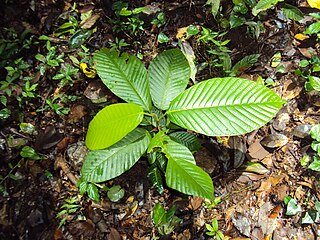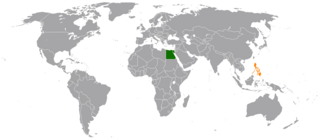
The karambit or kerambit, kurambik or karambiak is a small curved knife resembling a claw, associated with the Malays in Malaysia and Minangkabau of West Sumatra, Indonesia. The karambit is one of the weapons commonly used in pencak silat and Filipino martial arts.

Salacca is a genus of about 20 species of palms native to Southeast Asia and the eastern Himalayas. They are dioecious and pollinated by Curculionidae beetles.

Antidesma is a genus of tropical plant in the family Phyllanthaceae formally described by Linnaeus in 1753. It is native to tropical Africa, S + E + SE Asia, Australia, and various oceanic islands. The greatest diversity occurs in Southeast Asia.

Canarium is a genus of about 120 species of tropical and subtropical trees, in the family Burseraceae. They grow naturally across tropical Africa, south and southeast Asia, Indochina, Malesia, Australia and western Pacific Islands; including from southern Nigeria east to Madagascar, Mauritius, Sri Lanka and India; from Burma, Malaysia and Thailand through the Malay Peninsula and Vietnam to south China, Taiwan and the Philippines; through Borneo, Indonesia, Timor and New Guinea, through to the Solomon Islands, Vanuatu, New Caledonia, Fiji, Samoa, Tonga and Palau.
Microdesmis is a genus of plant of the family Pandaceae. It is native to tropical Africa, China and Southeast Asia.
- Microdesmis afrodecandraFloret, A.M.Louis & J.M.Reitsma - Gabon
- Microdesmis camerunensisJ.Léonard - Cameroon, Gabon, Congo-Brazzaville
- Microdesmis caseariifoliaPlanch. ex Hook -Guangdong, Guangxi, Hainan, Yunnan, Bangladesh, Cambodia, Borneo, Sumatra, Laos, Malaysia, Myanmar, Philippines, Thailand, Vietnam
- Microdesmis haumanianaJ.Léonard - Gabon, Congo-Brazzaville, Zaïre, Angola
- Microdesmis kasaiensisJ.Léonard - Zaïre
- Microdesmis keayanaJ.Léonard - Benin, Ghana, Guinea, Ivory Coast, Liberia, Sierra Leone, Togo, Nigeria
- Microdesmis klaineiJ.Léonard - Gabon
- Microdesmis magallanensis(Elmer) Steenis - Luzon, Sibuyan
- Microdesmis pierlotianaJ.Léonard - Cameroon, Gabon, Congo-Brazzaville, Zaïre, Central African Republic
- Microdesmis puberulaHook.f. ex Planch - widespread across central Africa from Nigeria east to Uganda, south to Angola
- Microdesmis yafunganaJ.Léonard - Zaïre

Drypetes is a plant genus of the family Putranjivaceae, in the order Malpighiales.

Dipterocarpus is a genus of flowering plants and the type genus of family Dipterocarpaceae.

Daphniphyllum is the sole genus in the flowering plant family Daphniphyllaceae and was described as a genus in 1826. The genus includes evergreen shrubs and trees mainly native to east and southeast Asia, but also found in the Indian Subcontinent and New Guinea.

Arenga is a genus of palms, native to Southeast Asia, southern China, New Guinea, and northern Australia. They are small to medium-sized palms, growing to 2–20 m tall, with pinnate leaves 2–12 m long. Arenga palms can grow in areas with little sunlight and relatively infertile soil.

Oncosperma is a genus of flowering plant in the family Arecaceae. It contains the following species, native to Southeast Asia and Sri Lanka:
The Southern Asia-Pacific Division (SSD) of Seventh-day Adventists is a sub-entity of the General Conference of Seventh-day Adventists, which coordinates the Church's activities in the nations of Bangladesh, Brunei, Burma, Cambodia, Indonesia, Laos, Malaysia, Pakistan, the Philippines, Singapore, Sri Lanka, Thailand, East Timor, and Vietnam. Its headquarters is in Silang, Cavite, Philippines. The Division has 1,868,258 members as of 2022.
Leptaspis is a genus of Paleotropical plants in the grass family, native to Africa, southern Asia, northern Australia, and a few islands of the western Pacific.

Saletara liberia is a butterfly of the family Pieridae. It is found in Indonesia, the Philippines, Peninsular Malaysia and various islands in the region. Subspecies S. l. distanti is known by the common name Malaysian albatross.

Belanda Hitam was an Indonesian language term used to refer to Black soldiers recruited by the Dutch colonial empire for service in the Royal Netherlands East Indies Army (KNIL), the colonial army of the Dutch East Indies. The recruitment of Black soldiers into the KNIL resulted from a combination of factors, including the heavy losses suffered by Dutch forces in the Java War and concerns over the reliability of indigenous KNIL troops. Between 1831 and 1872, over 3,000 West Africans, mostly Akan people, were recruited from the Dutch Gold Coast for KNIL service in the East Indies.

Hetaeria, commonly known as hairy jewel orchids, is a genus of about thirty species of flowering plants in the orchid family Orchidaceae. Plants in this genus are terrestrial herbs with a succulent rhizome and a loose rosette of leaves. Small, pale, hairy non-resupinate flowers are borne on a thin, hairy flowering stem. They are found in tropical Africa and Asia to New Guinea, Australia and some Pacific Islands.

Losaria neptunus, the yellow-bodied club-tail or yellow club-tail, is a species of butterfly from the family Papilionidae that is found in Sumatra, south Burma, north Borneo and the Philippines

Egypt–Philippines relations refers to the bilateral relations between Egypt and the Philippines. Egypt has an embassy in Manila, and the Philippines has an embassy in Cairo.














